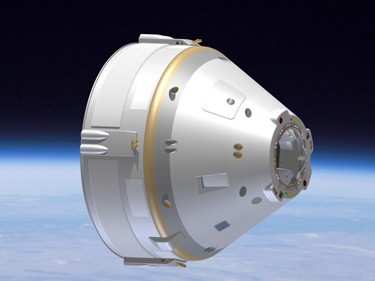Wed, Dec 15, 2010
Spacecraft Resembles Apollo Configuration With Crew And Service
Modules
Boeing has pulled the trigger on its proposal for the second
round of NASA's Commercial Crew Development (CCDev) program. The
company plans to advance the design of its Crew Space
Transportation (CST)-100 spacecraft and Commercial Crew
Transportation System and continue to demonstrate key
technologies.

Boeing Commercial Crew Concept
"In the same way that Boeing helped launch commercial aviation
more than 80 years ago, we are working to develop what could become
a true commercial space transportation system: a commercial service
to take people to the International Space Station and other Low
Earth Orbit destinations," said Brewster Shaw, Boeing Space
Exploration vice president and general manager. "We plan to further
mature our design and continue the development process toward our
first crewed flight in 2015."
The proposal is for an approach that will significantly mature
the CST-100 design through demonstrations of critical subsystems.
The CST-100 spacecraft is designed to support NASA's primary
objective of affordable access to Low Earth Orbit. It will carry up
to seven crew and passengers, is reusable up to 10 times, and is
compatible with a variety of expendable launch vehicles. The
spacecraft -- which is comprised of a Crew Module and a Service
Module -- draws on Apollo-proven aerodynamic characteristics in a
design that uses commercial, off-the-shelf, cost-effective
technologies.

In October, Boeing completed a Systems Definition Review with
NASA that defined the CST-100 spacecraft's system characteristics
and configuration and established a baseline design. Other major
accomplishments of the first round include:
- Design, build and test of a pressurized structure of the crew
module
- Creation of a mock-up of the spacecraft to ensure the crew can
enter and exit the vehicle safely, reach control switches and
easily see through windows
- Demonstration of manufacturability of the base heat shield
structure and thermal protection system to protect the crew during
re-entry into Earth's atmosphere
- Development of an avionics systems integration facility to
support rapid prototyping and full-scale development
- Development of a rendezvous sensor and associated guidance and
navigation software that allows the vehicle to autonomously
approach and dock with the International Space Station and the
planned Bigelow Orbital Space Complex
- Demonstration of airbag land landing, water landing, post-water
landing uprighting and life-support systems.
"We look forward to continuing our joint efforts with NASA to
ensure CCDev's success," said Shaw. "Enabling commercial-crew
access to Low Earth Orbit allows NASA to focus on deep space
exploration and thereby ensure a continued leadership role for the
U.S. in human spaceflight for generations to come."
More News
Aero Linx: Transport Canada We are a federal institution, leading the Transport Canada portfolio and working with our partners. Transport Canada is responsible for transportation p>[...]
Gross Navigation Error (GNE) A lateral deviation from a cleared track, normally in excess of 25 Nautical Miles (NM). More stringent standards (for example, 10NM in some parts of th>[...]
From AirVenture 2017 (YouTube Edition): Flight-Proven Booster On Display At AirVenture… EAA AirVenture Oshkosh is known primarily as a celebration of experimental and amateu>[...]
Aircraft Parachute System (CAPS) Was Deployed About 293 Ft Above Ground Level, Which Was Too Low To Allow For Full Deployment Of The Parachute System Analysis: The day before the a>[...]
Also: 48th Annual Air Race Classic, Hot Air Balloon Fire, FAA v Banning 100LL, Complete Remote Pilot The news Piper PA-18 Super Cub owners have been waiting for has finally arrived>[...]
 ANN's Daily Aero-Linx (06.29.25)
ANN's Daily Aero-Linx (06.29.25) ANN's Daily Aero-Term (06.29.25): Gross Navigation Error (GNE)
ANN's Daily Aero-Term (06.29.25): Gross Navigation Error (GNE) Classic Aero-TV: Anticipating Futurespace - Blue Origin Visits Airventure 2017
Classic Aero-TV: Anticipating Futurespace - Blue Origin Visits Airventure 2017 NTSB Final Report: Cirrus SR22
NTSB Final Report: Cirrus SR22 Airborne Affordable Flyers 06.26.25: PA18 Upgrades, Delta Force, Rhinebeck
Airborne Affordable Flyers 06.26.25: PA18 Upgrades, Delta Force, Rhinebeck




